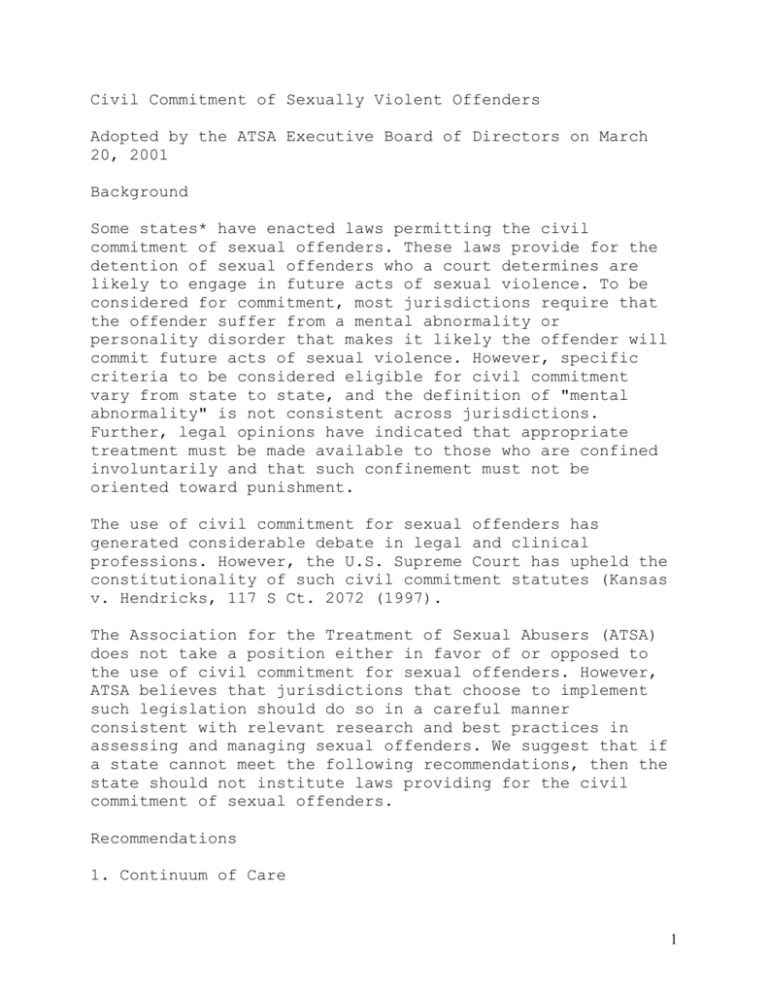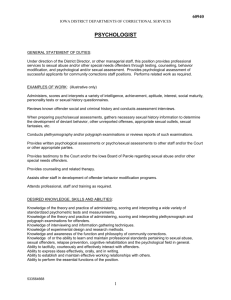Civil Commitment of Sexually Violent Offenders
advertisement

Civil Commitment of Sexually Violent Offenders Adopted by the ATSA Executive Board of Directors on March 20, 2001 Background Some states* have enacted laws permitting the civil commitment of sexual offenders. These laws provide for the detention of sexual offenders who a court determines are likely to engage in future acts of sexual violence. To be considered for commitment, most jurisdictions require that the offender suffer from a mental abnormality or personality disorder that makes it likely the offender will commit future acts of sexual violence. However, specific criteria to be considered eligible for civil commitment vary from state to state, and the definition of "mental abnormality" is not consistent across jurisdictions. Further, legal opinions have indicated that appropriate treatment must be made available to those who are confined involuntarily and that such confinement must not be oriented toward punishment. The use of civil commitment for sexual offenders has generated considerable debate in legal and clinical professions. However, the U.S. Supreme Court has upheld the constitutionality of such civil commitment statutes (Kansas v. Hendricks, 117 S Ct. 2072 (1997). The Association for the Treatment of Sexual Abusers (ATSA) does not take a position either in favor of or opposed to the use of civil commitment for sexual offenders. However, ATSA believes that jurisdictions that choose to implement such legislation should do so in a careful manner consistent with relevant research and best practices in assessing and managing sexual offenders. We suggest that if a state cannot meet the following recommendations, then the state should not institute laws providing for the civil commitment of sexual offenders. Recommendations 1. Continuum of Care 1 The Association for the Treatment of Sexual Abusers recommends that, if a state chooses to utilize civil commitment laws, these laws be one part of a comprehensive continuum of responses to sexual offending behavior. Civil commitment should be seen as the last response along an established continuum of options. Offenders should have the opportunity to participate in treatment before they are considered for civil commitment. Usually this means access to treatment within the prison environment. Ideally, the evaluation of sexual offenders should occur before sentencing. Granting parole or any type of early release would be related directly to progress in treatment and other measures of reduced recidivism risk. The option of long-term or life-long specialized parole and probation could also serve as an appropriate method of managing highest risk offenders and could serve as an alternative to civil commitment where appropriate. A variety of community treatment options should exist ranging from weekly to daily treatment and supervision. In all instances, intensive supervision (e.g., probation or parole) is recommended when an offender is released to the community. Residential treatment, whether hospital or prison-based, should be available for those who require more structured and secure treatment. Both community-based and residential treatment should utilize interventions that have strong research support for being the most effective, as well as medication when appropriate. Currently, the cognitive behavioral therapies appear to be the most effective treatment. 2. Risk Assessment The Association for the Treatment of Sexual Abusers recommends that assessments of an individual in a civil commitment proceeding be based on the best available scientific knowledge, including the use of current, validated risk assessment instruments. Professionals performing such evaluations should be well trained, qualified and experienced in the evaluation and treatment 2 of sexual offenders and should follow established ethical and professional standards. ** To most accurately evaluate the risk of future sexual violence, the evaluator should include the best available actuarial instruments that have been validated as risk predictors for the population to which they will be administered. An actuarial instrument is a system for assessing risk using specific factors, with specific scoring rules, which indicates placement of an individual within a certain risk group. The evaluator’s choice of risk assessment instrumentation needs to be reasonably related to the subject and task. No psychological test (e.g., Rorschach Inkblot Test, MMPI, MSI) should be employed specifically for this type of risk assessment unless scientific evidence of its validity relative to this type of risk assessment has been established. 3. Appropriate Treatment and Housing The Association for the Treatment of Sexual Abusers recommends proper housing and treatment for people who are civilly committed. The treatment program should be consistent with current standards for the treatment of sexual offenders and include all the components recognized as necessary for the success of treatment, as well as include all necessary general mental health features. Individualized treatment plans are critical and should provide for systematic measurements of the individual’s progress. The program should be structured with identifiable phases so individuals can mark their progress in treatment. The goals and objectives of treatment should be clearly delineated at the intake stage and one or more objective indicators, in addition to clinical opinion, should be continually used to determine treatment progress. Evaluation should occur at regular intervals and the criteria to be met for obtaining release should be clearly defined at the outset of treatment. Since civil commitment laws have arisen out of the public concern for community safety, programs should be designed to provide mental health treatment that meets accepted professional standards and should be located where they can 3 provide the greatest degree of security while the offender is being treated. The program should be housed in a treatment-oriented facility that is structurally similar, but physically separate, from other programs for the mentally ill. Staff in civil commitment facilities and programs should be adequately trained, qualified and appropriately licensed and supervised. A program should establish internal and external multi-disciplinary bodies to provide oversight of program, staff, and client issues. 4. Transition to the Community The Association for the Treatment of Sexual Abusers recommends that offenders should be committed in the least restrictive manner possible consistent with their risk to the community. As programs are designed to reduce risk, gradual return to the community should be built into the treatment process. Civil commitment programs need to develop methods for a resident to be conditionally released to a less restrictive setting, consistent with the need for community safety. The transition needs to include more than referral to an outpatient treatment program. Community visitation, work release, approved housing and employment, family support systems, supervision, monitoring and ongoing treatment are crucial to the success of re-entry into the community. Service and supervision intensity should be matched to the offender’s level of risk. 5. Funding of Civil Commitment Programs The Association for the Treatment of Sexual Abusers recommends that a state not divert funds from other mental health programs to fund civil commitment. 6. Review of Sentencing Policies The Association for the Treatment of Sexual Abusers recommends that each state review its process of assessing and sentencing sexual offenders. ATSA believes that a process that assesses the offender at the post-trial, pre-sentence phase may be the most 4 efficient and effective manner of determining risk. Each offender should have the opportunity to receive treatment prior to the possibility of civil commitment. The consistent use of evaluations may lessen the need for civil commitment by helping to ensure risk-based sentencing decisions in the criminal justice system. 7. On-Going Research The Association for the Treatment of Sexual Abusers recommends that States support on-going research to investigate the impact of civil commitment on individuals and on the community, as well as to determine the most effective treatment methods to use in the provision of sexual offender treatment. 8. Judicious Use of Civil Commitment Laws The Association for the Treatment of Sexual Abusers recommends that if civil commitment is to be used, it be reserved for the most serious, chronic sexual offenders whose risk to others has not been reduced by prior treatment or other mitigating factors. * As of January 2001, fifteen states have civil commitment laws. The states are: Arizona, California, Florida, Illinois, Iowa, Kansas, Massachusetts, Minnesota, Missouri, North Dakota, New Jersey, South Carolina, Texas, Washington, and Wisconsin. Virginia has also passed such a law, to be implemented July 1, 2001. **Specific information regarding current ethical and professional standards for professionals in the field of sexual offending, as well as additional resources can be obtained from the Association for the Treatment of Sexual Abusers. 5






